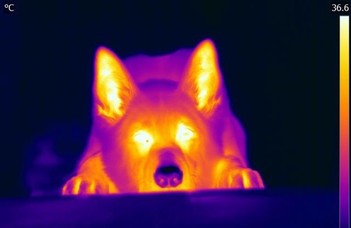Infrared sensing in dogs’ nose

In a collaborative study of Lund University, Sweden and Eötvös Loránd University, Hungary, researchers discovered that the dog’s rhinarium (the naked, wet skin surface at the tip of the nose) works as an infrared sensor which can sense weak thermal radiation. Researchers have demonstrated this in a series of experiments, first by training dogs on weak heat signals and then by functional magnetic resonance imaging (fMRI), visualizing the induced activity in the dog brain. The discovery of a hitherto unknown sense can help us better understand how predators can detect their prey when known senses such as sight, hearing or smell are hindered. The study was recently published in Scientific Reports.
Most mammals have a conspicuous feature on their nose-tip around the nostrils called a rhinarium. In a few species, the rhinarium has a known sensory function, such as the tactile sensitivity of moles in general (and star-nosed mole (Condylura cristata) in particular) or the mechanosensitive rhinarium of the racoon (Procyon lotor) and the coati (Nasua nasua). Interestingly, the temperature of the carnivoran rhinarium in awake animals is considerably lower than in other mammalian groups. Low tissue temperature usually impairs sensory sensitivity, with one known exception: crotaline snakes strike more accurately if their infrared-sensitive pit-organs are colder. The researchers speculated that since the closest wild relative of domestic dogs, the grey wolf (Canis lupus) preys predominantly on large endothermic prey, the ability to detect the radiation from warm bodies would be advantageous for them, and also for other carnivores.
To test this idea, researchers designed two complementary experiments to find out if dogs can sense infrared radiation and show a directed behavioral response to it. In a series of behavioral experiments at Lund University, Sweden, the researchers trained dogs to detect weak thermal radiation in a two-alternative forced-choice paradigm in which dogs had to choose between a warm (cca. 31°C) and an ambient-temperature object. The dogs were able to choose the warmer object from a distance that is relevant for hunting, without being able to see or smell the difference between them. In another series of experiments at Eötvös Loránd University, Hungary, dogs were tested in a brain scanner with a warm and an ambient-temperature object to elucidate if there is any brain region where neural activity increases when animals are presented with a source of weak thermal radiation. The researchers found that in the left somatosensory cortex in the brain, a region encoding inputs from the nose was more responsive to the warm thermal stimulus than to the neutral one.
“From the two, complementary experiments, we can conclude that dogs are indeed capable of sensing thermal radiation emanating from warm-blooded animals, use this sensory information for directed behaviour that could be relevant for hunting, and that a specific region of the somatosensory system is activated by such infrared radiation” – says lead author Anna Bálint, postdoctoral researcher at the Department of Ethology, Eötvös Loránd University, Hungary. Since the details of the sensory mechanism are as yet unknown, it is possible that so far unknown cellular-molecular mechanisms are in the background of the process” – adds Bálint.
“The canine heat sense had been overlooked for thousands of years” – says principal investigator Ronald H.H. Kröger, professor at the Mammalian Rhinarium Research Group, Lund University, Sweden. “It is possible that other carnivorans possess a similar infrared sense and that adds a new chapter to the story of prey-predator relationships. Predator hunting strategies have to be re-evaluated and the biology of prey animals has to be revisited with body heat sensing predators in mind. There are dogs all over the world, so that labs of varying backgrounds can easily perform further studies. There is also a wide public and professional interest in dogs and their capabilities, so we hope that further studies investigating the details of this newly discovered sense will receive much professional and public interest”-continues Kröger.
This research was published on 28 February 2020 in Scientific Reports, titled Dogs can sense weak thermal radiation. The work was funded by the Agria/SKK Research Fund, the Olle Engkvist Byggmästare Foundation, the Hungarian Academy of Sciences, the Hungarian Ministry of Human Capacities, and the National Research, Development and Innovation Office of Hungary.
Video abstract about the research:
Direct link to the article: www.nature.com/articles/s41598-020-60439-y

